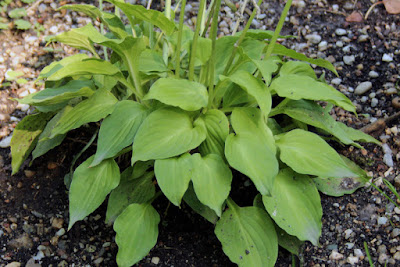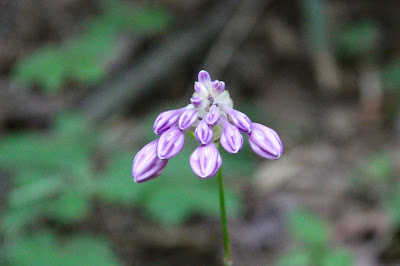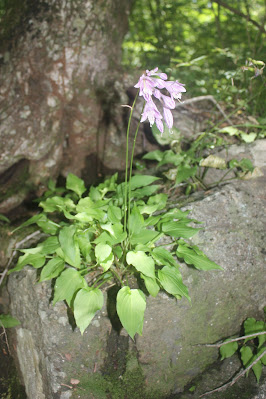Hosta capitata - Hosta nakaiana is found in the southern part of the Korean peninsula and in Japan (Honshu, Shikoku, Kyushu).
Hosta capitata, also called as Hosta nakaiana, Hosta caerulea var. capitata, is a species of the genus Hosta. This species was described by Takenoshin Nakai in 1930.
IDENTIFY HOSTA CAPITATA - HOSTA NAKAIANA
Hosta capitata is found in the southern part of the Korean peninsula and in Japan (Honshu, Shikoku, Kyushu). In Korea, it usually grows in pine-oak understories and grasslands in montane regions. In Japan it usually grows on limestone cliffs and outcrops in river valleys.
It is a herbaceous perennial plant which reaching 25 cm high. The leaves are15-20cm long, petioles narrow with purple spotted at base. The tall scapes are characteristic throughout the species, but, depending on population source, there is considerable variation in leaf size.
This species blooms in June to July from the 40-70 cm tall scapes with tightly clustered flowers. The flowers are bell-shaped, purple or white (forma albiflora) corollas ca. 4-5cm long, 6 stamens, length of stamen is same as corollas. Fruits 2.5-2.7cm long.
HOSTA CAPITATA - HOSTA NAKAIANA CARE AND CULTURE
Cultural information should only be used as a guide, and should be to be adapted to suit you. Your physical location; where you grow your plants, how much time you have to devote to their care, and many other factors, will need to be taken into account. Only then can you decide on the cultural methods that best suit you and your plants.
Light:
Hosta capitata do great in shade. Plants grown in full afternoon sun will show signs of marginal burning on leaves in the summer months. It perform best when there is a limited amount of direct or filtered sun during the day. Early day sun to about mid-morning & late afternoon sun after 5pm will not burn the leaves.
Temperature:
This species do well from USDA Hardiness Zone 3 (-40°F minimum) southward as far as zone 9 (20°F minimum). It need a period of cold weather, at the onset of which they turn a pleasing yellow and then go dormant. Insufficient winter chill and dry air, such as in western deserts, are the chief limiting factors.
Substrate and growing media:
Hosta capitata grow best in well drained, slightly acidic pH, rich organic soil. The plant can also be grown attractively in containers or pots without replanting for two to three or more years given a proper container size, frequent watering, & fertilizing.
When making a new bed, many gardeners like to cultivate to a depth of 12-16 inches. Apply 6 inches of organic matter and till it into the new bed. Materials such as compost, leaf mold, well-rotted manure, peat moss, composted pine bark, and municipal sludge products may be used. The addition of organic matter will also serve to raise the bed, which will improve drainage for the plants. The ideal pH range is 6.5-7.5, which is slightly acidic to slightly alkaline. In higher pH soils, the addition of organic matter such as Canadian peat moss and cottonseed meal will tend to lower the pH.
The planting hole should be dug at least a foot deep. The width of the hole should be one and a half times the expected mature size of the clump. Their roots will grow and spread horizontally, so a large, wide hole is best.
Watering:
Water is important for optimal growth. A minimum of an inch of water each week is recommended, and can come from rain, irrigation, or hand watering. The plants that are grown in sandy soil may need even more water because of the increased drainage provided by the sandy conditions. In general, the greatest growth occurs when water exceeds the minimum recommended rate. Watering on a regular basis early in the day is highly recommended. The soil should also be checked to make sure runoff is not occurring. A deep watering will ensure good root development.
If the plants do not receive sufficient water, they will begin to go dormant. The plant will wilt followed by a browning and then loss of leaves. This is your plants way of conserving energy and protecting the crown from death. But, if the soil is perpetually soggy, this can create rot. The most critical time to water consistently for successful growing is when the plant break dormancy in spring & when they begin the dormancy process in early fall.
Fertilizer:
A balanced granular fertilizer such as 10-10-10 or 5-10-5 can be applied early in the spring, followed by an application six weeks later, followed by a midsummer application. Timing of these applications would typically be early April, mid- to late May, and mid-July.
For optimal results it is recommended that you have a soil test done to see what your soil is lacking before deciding what to fertilize with. Many gardens do not need additional fertilizer if a soil test shows the soil has sufficient amounts of the necessary nutrients. In this case, an addition of compost over the bed once a year, applied in the fall, is usually sufficient.
Pruning and mulching:
In early summer, apply approximately 1 inch of loose organic mulch to inhibit weed growth, reduce water loss and lessen soil compaction. A thick layer of mulch is likely to promote slug populations. Water in the morning so the mulch surfaces dry before evening, and occasionally rake the mulch to improve air movement.
Winter mulch should applied to help newly planted hostas from repeated freezing and thawing of the soil. Remove any remaining foliage before a winter mulch is added or snow covers the plants. Remove the winter mulch along with leaf debris in early spring prior to visible growth.
Winter period:
This species begin to go dormant in September. Temperatures play a major role in how fast they go dormant. To begin winterizing, if necessary, keep supplying them with an inch or so of water per week throughout the fall. If you have been fertilizing the plants, stop feeding them in late summer or they will continue to produce leaves. These tender new leaves can make the entire plant, including the crown and roots, susceptible to frost damage
It is best to leave them be until the leaves have lost all coloration as this is when they have stopped storing sugar. Then, you can pull off the dead leaves or let them turn into compost through the winter. Clean the pots and display beds in late fall to early winter as it is one less place for slugs to hide & gives a clean look to the winter beds. The plant in the ground begin to emerge here in late March & are fully developed by mid May.
Pests and diseases:
The most common pests the plant will encounter are snails and slugs. A somewhat water resistant bait has given us excellent results in controlling their population & keeping them off the plants. The two best times to bait is in October & February, this will greatly increase the kill rate for season, as there is usually a warmer, dry period in the month when the slugs come out looking for food & lay eggs. Keep in mind pets when using slug bait.
Also, deer may give the plant a try while foraging. Deer that do eat the plant seem to prefer hosta with thinner leaf substance. There is a large array of ways of keeping deer away & repellents available.
Virus are of concern and are an emerging and important issue in growing hostas. Symptoms include an irregular mottling of the foliage, yellow ringspots, or small yellow dots or flecks on the leaves. If a virus is present, the plant should be discarded and tools used in the hosta planting should be disinfected.
Propagation:
Hosta capitata begins to show its mature characteristics after three years and should be fully mature at five years. It is easily propagated by dividing existing plants. Some growers do not divide the display hostas, as each year they are left undisturbed, they look more and more stunning.
The plant can be divided about any time of the year in more temperate climates where the summers are warm but the nights cool off such as our western Oregon climate. If you live in an area that gets hot and humid summers such as the Midwest & southern states, it is recommended that you split your plants in spring or wait until the summer heat begins to fade & the night time temperatures begin to fall back. If you try to divide your plant under hot, humid conditions, you may have problems with crown rot.
To divide your plants use a sharp knife to cut through the basal plate of hard tissue between the foliage & roots. Divisions are best when an eye is left with some basal plate & roots. Then this can be planted. It is a great way to increase the stock you have for mass plantings with a limited purchase or to share your hosta with friends. Keep newly divided plants well watered for the first two weeks, especially if there is a period of drought. Some of the larger leaves on a division may be cut back to reduce water loss. Frequent division of a clump will restrict plant and leaf size, and keep it from developing to its desirable mature features.

















COMMENTS